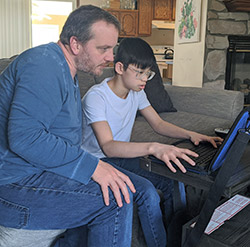As the world settles into an unprecedented new normal, virtual school has become a reality for students.
Seventh grader Sawyer Holst’s first reaction when he woke up to the news on Friday March 13 was – probably like many of his peers – “Wow, no school for three weeks.”
But before the end of the day, the Sparta Middle School Directory of Distance Learning was in place – complete with a variety of online resources and suggestions for daily learning activities from every teacher.
Principal Brad Wood credits a hard working staff, district communications and student use of Chromebooks for the quick turnaround.
The $58 million bond passed in 2016 provided every Sparta student a Chromebook, and the practice of using them has provided students with the skills for learning and working online as well as communicating with teachers by way of a personal computer.
“(Superintendent Pete Bush) has done a really good job of communicating information about this health crisis,” Wood said. “As soon as we knew we might close, we put what we already knew about the Google platform to good use.”
When Governor Whitmer announced mandatory school closing, staff used the last day they were able to be together to “communicate with each other ways they could best help their students access learning resources and connect with kids for feedback,” he said.

Online Options
While not required by the district, if parents insist on daily lessons or the students choose to stay on a regular schedule, the virtual school offers many opportunities to keep young minds engaged.
Social studies teachers have posted videos like Ancient Greece and provided weekly geography challenges such as: “Learn your countries of the world. Take a screenshot of your 100% accuracy. Each completed game with 100% accuracy will earn you a prize. Prizes will get better with the more completed weekly geography challenges.”
Language arts teachers have provided many reading resources as well as lists of daily writing prompts, which are also used in regular classes.
“These are things we do in class on a regular basis and hopefully the students enjoy putting their thoughts down,” said teacher Steve Duyck. “We are suggesting that they write on each topic for no more than 10 minutes. Sometimes in class, I only give them three minutes. I find it is kind of a psychological thing for them to have an idea and want to keep writing.”
Another language arts teacher is providing students the opportunity to do a “book talk” via video and submit it by email.
Math teacher Erin Ondrusek is encouraging her students to continue with their regular study skills program by way of the usual online practice and review programs. “I am suggesting that the students practice math skills 30 minutes each day to brush up on their skills,” she said.

Keeping Up With Friends
Ondrusek has also used the Remind App to set up small group discussions.
“I tried it with a few eighth graders and about seven responded,” she said. “I didn’t have much of an agenda, just wanted to connect to see what they would like me to prepare for them or if they had any questions. It was very interesting; they seemed to have fun seeing each other and playing around with backgrounds, but I think it was good for us to get together.”
Social interaction for middle schoolers is a definite concern, said Wood. “Of course we think about them missing school, their regular routines and opportunities to connect with their peers, but in every tough situation, there are new opportunities. In this case it might be to use technology in new and positive ways, such as for learning and for finding ways to communicate with families and friends to continue to have fun together,” he said.
Specialty classes present different challenges but teachers are finding creative ways to keep student minds active.
Duyck also teaches photography and said students normally take pictures with school equipment during class. He realizes not all students have access to photography equipment; however: “This (closure) might provide an opportunity for them to explore their unique situations and when we return to share with the class what they experienced,” he said.
The directions for producing a photo essay have prompted some students to contact Duyck for further instruction or suggestions. “I am encouraging them to send in their ‘essays’ and I will share them with the class,” he said. The online virtual school is on the school website and Facebook links if students of other schools would like to access the resources, said Wood.









